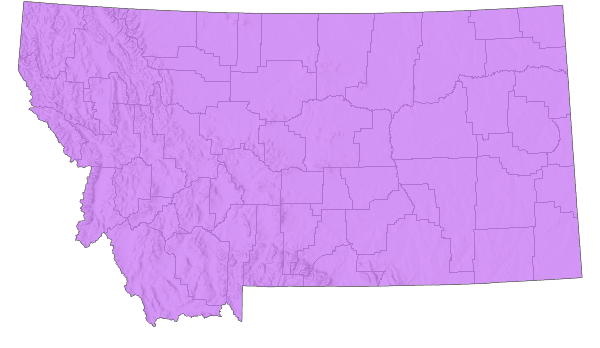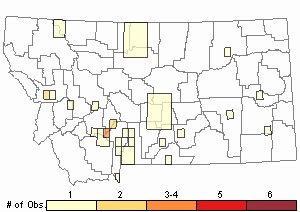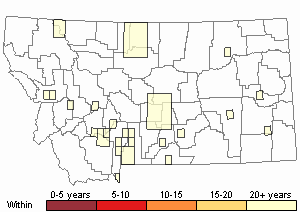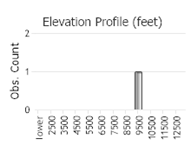View in other NatureServe Network Field Guides
NatureServe
Montana
Utah
Wyoming
Idaho
Wisconsin
British Columbia
South Carolina
Yukon
California
New York
Little Spur-throat Grasshopper - Melanoplus infantilis
Other Names:
Tiny Spur-throat Grasshopper
General Description
The following comes from Hebard (1928), Brooks (1958), Helfer (1971), Capinera et al. (2004), Capinera and Sechrist (1982), Vickery and Kevan (1985), Pfadt (2002), Schell et al. (2005), Brust (2008), and Scott (2010). As its name indicates, this is a small species within the Melanoplus genus, but not the smallest. Body color is brownish or gray. The wings (tegmina) are long, extending beyond the abdomen tip and centrally with alternating light and dark spots. The outer face of the hind femur has two oblique pale bands. The hind tibia is pale blue.
Phenology
Overwinters in the egg stage. Eggs hatch from late May to mid-June and are present from June through August. Adults occur from August through October (Capinera et al. 2004, Capinera and Sechrist 1982, Vickery and Kevan 1985, Pfadt 2002, and Scott 2010).
Diagnostic Characteristics
The following is from Hebard (1928), Brooks (1958), Helfer (1971), Capinera et al. (2004), Capinera and Secrist (1982), Vickery and Kevan (1985), Pfadt (2002), Brust (2008), Schell et al. (2005), and Scott (2010). The body length to end of forewings is 14 to 17 mm for males, and 16 to 19 mm for females. The cercus of the male genitalia is diagnostic in shape, being forked with a small thumb-like dorsal projection and slightly curving pointed ventral arm.
Can be confused with the
Alpine Grasshopper, (
M. alpinus), which possesses a similarly shaped male cercus, but the ventral arm curves more strongly downward and ends in an acute point (Pfadt 2002, and Scott 2010).
Species Range
Montana Range
Range Descriptions

 Native
Native
Range Comments
The Little Spur-throat is widely distributed across western North America, occurring from western Minnesota and Iowa, westward to Washington, Idaho, Nevada; from British Columbia, Alberta, and Saskatchewan southward to northern Arizona and New Mexico. In Montana, it has been reported in 47 counties, but probably occurs statewide (Hebard 1928, Capinera et al. 2004, Capinera and Sechrist 1982, Vickery and Kevan 1985, Pfadt 2002, and Scott 2010).
Observations in Montana Natural Heritage Program Database
Number of Observations: 31
(Click on the following maps and charts to see full sized version)
Map Help and Descriptions
Relative Density

Recency



 (Observations spanning multiple months or years are excluded from time charts)
(Observations spanning multiple months or years are excluded from time charts)
Habitat
The following is taken from Capinera et al. (2004), Capinera and Sechrist (1982), Vickery and Kevan (1985), and Pfadt (2002). Generally, inhabits short-grass prairies and montane grasslands from 8,000 to 10,000 feet. Prefers open, treeless, dry, grassy and weedy areas with sandy and gravelly soils. Its northern geographic range and altitudinal distribution indicates that this species has a tolerance for colder temperatures and an intolerance for warmer conditions. It also possesses flight migration instincts and often flies into cities and towns.
Food Habits
Feeds on both grasses and forbs and is polyphagous. Preferred grass species include
blue grama, (
Bouteloua gracilis),
western wheatgrass, (
Elymus smithii),
needle-and-thread, (
Stipa comata) and dropseed. Sedges include
thread-leaved sedge, (
Carex filifolia), and
needleleaf sedge, (
Carex duriuscula). Favored forbs include
scarlet globemallow, (
Sphaeralcea coccinea),
woolly plantain, (
Plantago patagonica),
broom snakeweed, (
Gutierrezia sarothrae),
fringed sage, (
Artemisia frigida), Fendler's sandwort, dandelion, and several species of milkvetch.
Reproductive Characteristics
After hatching, nymphs pass through 5 instar stages before the adult stage. Egg pods contain 10 to 13 eggs arranged in two columns. Oviposition has been observed to occur in clumps of buffalo grass and in clay soils. There is only one generation per year. No further studies have been made of this species’ courtship and reproduction (Capinera and Sechrist 1982, and Pfadt 2002).
Management
Most of time, the Little Spur-throat exist in small densities. Adults generally remain in the same habitat in which they developed as nymphs. They are subject to outbreaks and can reach higher population densities and are capable of dispersal and migratory flights. Usually found in an assemblage with other species where they can become pests on rangeland grasses (Pfadt 2002, and Schell et al. 2005).
Stewardship Responsibility
References
- Literature Cited AboveLegend:
 View Online Publication
View Online Publication Brooks, A.R. 1958. Acridoidea of Southern Alberta, Saskatchewan, and Manitoba (Orthoptera). The Canadian Entomologist (Supplement 9) 90:5-92.
Brooks, A.R. 1958. Acridoidea of Southern Alberta, Saskatchewan, and Manitoba (Orthoptera). The Canadian Entomologist (Supplement 9) 90:5-92. Brust, M.L, W.W. Hoback, and R.J. Wright. 2008. The Grasshoppers of Nebraska. Lincoln, NB: University of Nebraska Extension Service, APHIS.
Brust, M.L, W.W. Hoback, and R.J. Wright. 2008. The Grasshoppers of Nebraska. Lincoln, NB: University of Nebraska Extension Service, APHIS. Brust, M.L., W.W. Hoback, and R.J. Wright. 2008. A Synopsis of Nebraska Grasshopper Distributions. Journal of the Kansas Entomological Society 81(3):208-255.
Brust, M.L., W.W. Hoback, and R.J. Wright. 2008. A Synopsis of Nebraska Grasshopper Distributions. Journal of the Kansas Entomological Society 81(3):208-255. Capinera, J.L. and T.S. Sechrist. 1982. Grasshoppers of Colorado: Identification, Biology, and Management. Fort Collins, CO: Colorado State University Experiment Station, Bulletin 584S. 161 p.
Capinera, J.L. and T.S. Sechrist. 1982. Grasshoppers of Colorado: Identification, Biology, and Management. Fort Collins, CO: Colorado State University Experiment Station, Bulletin 584S. 161 p. Capinera, J.L., R.D. Scott, and T.J. Walker. 2004. Field Guide to Grasshoppers, Katydids, and Crickets of the United States. Ithaca, NY. Cornell University Press.
Capinera, J.L., R.D. Scott, and T.J. Walker. 2004. Field Guide to Grasshoppers, Katydids, and Crickets of the United States. Ithaca, NY. Cornell University Press. Hebard, M. 1928. The Orthoptera of Montana. Proceedings of the Academy of Natural Sciences of Philadelphia, Vol. 80:211-306.
Hebard, M. 1928. The Orthoptera of Montana. Proceedings of the Academy of Natural Sciences of Philadelphia, Vol. 80:211-306. Helfer, J.R. 1971. How to Know the Grasshoppers, Crickets, Cockroaches, and Their Allies. Revised edition (out of print), Mineola, NY: Dover Publications.
Helfer, J.R. 1971. How to Know the Grasshoppers, Crickets, Cockroaches, and Their Allies. Revised edition (out of print), Mineola, NY: Dover Publications. Pfadt, R.E. 2002. Field Guide to Common Western Grasshoppers, 3rd edition. Laramie, WY: Wyoming Agricultural Experiment Station, Bulletin 912, modified by S. Schell and S. Schell for electronic publication. Accessed 19 February 2020. http://www.uwyo.edu/entomology/grasshoppers/field-guide/index.html#fieldguidetoc
Pfadt, R.E. 2002. Field Guide to Common Western Grasshoppers, 3rd edition. Laramie, WY: Wyoming Agricultural Experiment Station, Bulletin 912, modified by S. Schell and S. Schell for electronic publication. Accessed 19 February 2020. http://www.uwyo.edu/entomology/grasshoppers/field-guide/index.html#fieldguidetoc Schell, S.P., A.V. Latchininsky, and B.A. Shambaugh. 2005. Common Wyoming Pest Grasshoppers. 2nd Edition B-1161.Laramie, WY: University of Wyoming Cooperative Extension Service and Department of Renewable Resources. 76 p.
Schell, S.P., A.V. Latchininsky, and B.A. Shambaugh. 2005. Common Wyoming Pest Grasshoppers. 2nd Edition B-1161.Laramie, WY: University of Wyoming Cooperative Extension Service and Department of Renewable Resources. 76 p. Scott, R.D. 2010. Montana Grasshoppers, Katydids, and Crickets A Pictorial Field Guide to the Orthoptera. MagpieMTGraphics, Billings, MT.
Scott, R.D. 2010. Montana Grasshoppers, Katydids, and Crickets A Pictorial Field Guide to the Orthoptera. MagpieMTGraphics, Billings, MT. Vickery, V. R. and D. K. M. Kevan. 1985. The grasshopper, crickets, and related insects of Canada and adjacent regions. Biosystematics Research Institute, Ottawa, Ontario. Publication Number 1777. 918 pp.
Vickery, V. R. and D. K. M. Kevan. 1985. The grasshopper, crickets, and related insects of Canada and adjacent regions. Biosystematics Research Institute, Ottawa, Ontario. Publication Number 1777. 918 pp.
- Additional ReferencesLegend:
 View Online Publication
View Online Publication
Do you know of a citation we're missing? Anderson, N.L. 1951. Field studies on the biology of range grasshoppers of southeastern Montana. M.Sc. Thesis. Bozeman, Montana: Montana State University. 96 p.
Anderson, N.L. 1951. Field studies on the biology of range grasshoppers of southeastern Montana. M.Sc. Thesis. Bozeman, Montana: Montana State University. 96 p. Anderson, N.L. 1962. Grasshopper-vegetation relationships on Montana grasslands. Ph.D Dissertation. Bozeman, Montana: Montana State University. 73 p.
Anderson, N.L. 1962. Grasshopper-vegetation relationships on Montana grasslands. Ph.D Dissertation. Bozeman, Montana: Montana State University. 73 p. Gillespie, R.L.1992. Dynamics of grasshoppers (Orthoptera: Acrididae) at a rangeland-crop interference. Ph.D. Bozeman, MT: Montana State University. 111 p.
Gillespie, R.L.1992. Dynamics of grasshoppers (Orthoptera: Acrididae) at a rangeland-crop interference. Ph.D. Bozeman, MT: Montana State University. 111 p. Larson, D.P. 1996. Evaluation of sweep sampling as a method for determining grasshopper community composition on rangeland. M.Sc. Thesis. Bozeman, MT: Montana State University. 92 p.
Larson, D.P. 1996. Evaluation of sweep sampling as a method for determining grasshopper community composition on rangeland. M.Sc. Thesis. Bozeman, MT: Montana State University. 92 p. Skinner, K.F. 1995. Plant and grasshopper community composition: indicators & interactions across three spatial scales. M.Sc. Thesis. Bozeman, MT: Montana State University. 144 p.
Skinner, K.F. 1995. Plant and grasshopper community composition: indicators & interactions across three spatial scales. M.Sc. Thesis. Bozeman, MT: Montana State University. 144 p. Wachter, D.H. 1995. The ecology of selected grasshopper species along an elevational gradient. M.Sc. Thesis. Bozeman, Montana: Montana State University. 59 p.
Wachter, D.H. 1995. The ecology of selected grasshopper species along an elevational gradient. M.Sc. Thesis. Bozeman, Montana: Montana State University. 59 p.
- Web Search Engines for Articles on "Little Spur-throat Grasshopper"
- Additional Sources of Information Related to "Insects"





